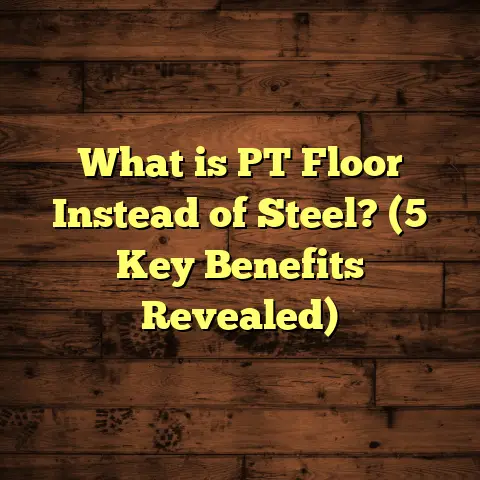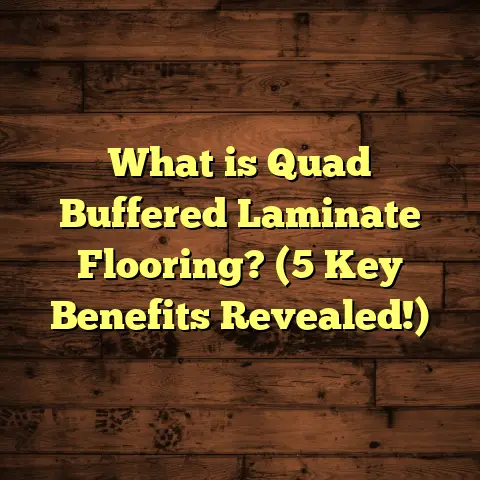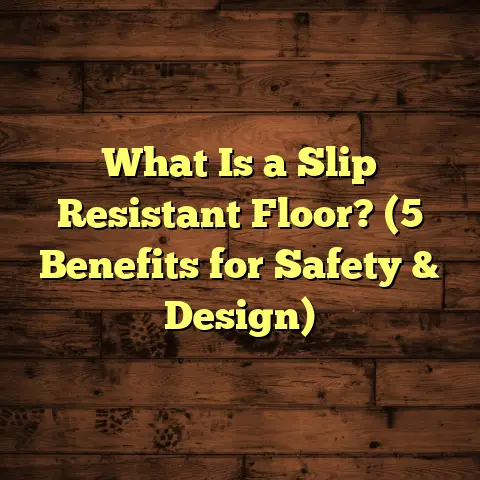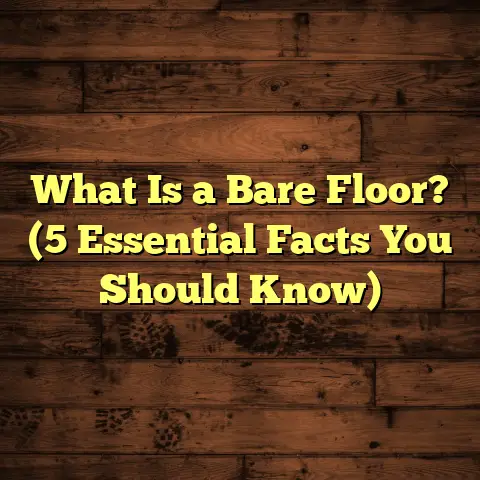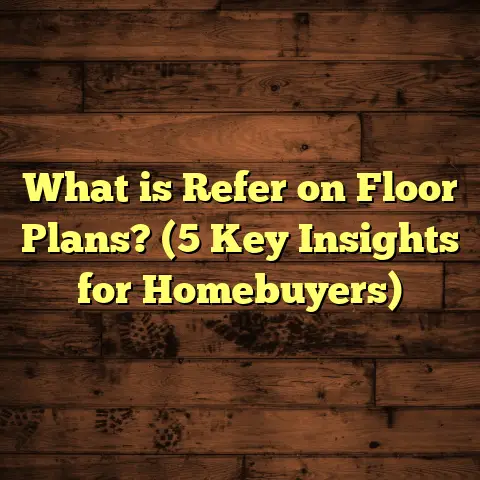What is a Low Floor HDB? (5 Key Benefits for Residents)
When I first started exploring affordable housing options in Singapore, I quickly came across the term “Low Floor HDB.” Honestly, at first, I thought it was just another technical phrase in the world of housing types. But as I dug deeper, I realized there’s more to these flats than just their price tags. Having been involved in home renovations and flooring projects for over a decade, I’ve had the chance to interact with many families who live in Low Floor HDB flats, and their stories really brought home the practical advantages. If you’re curious about what Low Floor HDB flats are all about and why so many people find them appealing, I’m here to break it down for you.
What Is a Low Floor HDB?
Let’s get this out of the way first: what exactly does “Low Floor HDB” mean? In Singapore, the Housing & Development Board (HDB) is the main agency responsible for public housing. The typical HDB flat is part of a multi-storey apartment block, often ranging from a few floors up to 20 or more.
A Low Floor HDB flat is simply an apartment unit located on one of the lower floors—usually floors 1 through 4. Sometimes, depending on the building design, it might include the ground floor or even the second floor. The key distinction is that these units are not situated high up where views might be better but accessibility might be trickier.
Why does this matter? The location of your flat within the block impacts several factors—price, convenience, safety, and lifestyle. Based on resale data from the past five years, it’s clear that Low Floor HDB flats tend to be priced lower than their higher-floor counterparts. This is mainly because many buyers associate higher floors with better views and prestige. But if you ask me—and many others—the benefits of living on a lower floor can outweigh those aesthetic perks.
Breaking Down the Characteristics
- Floor Level: Typically between 1st and 4th floor.
- Pricing: Between 5-10% cheaper than mid to high-floor units of similar size and layout.
- Accessibility: Easier access via stairs or shorter elevator rides.
- Proximity: Closer to communal facilities like playgrounds and community centers.
- Safety: Faster evacuation routes in emergencies.
I remember one young couple who chose a Low Floor HDB because they had a toddler and wanted easy access to the playground without having to cross busy roads or wait long for elevators. This choice made their daily routines smoother and less stressful.
Why Do People Choose Low Floor HDB Flats?
Before I dive into the specific benefits, it’s worth understanding why people select these flats despite the common desire for higher-floor views.
For one, affordability is a major factor. The price difference can be quite significant when purchasing or renting an HDB unit. For budget-conscious buyers, this translates into substantial savings that can go toward home improvements or other expenses.
Accessibility is another big reason. Elderly residents or families with young children often prefer lower floors because it involves less climbing or waiting for elevators. This convenience makes everyday living easier.
Also, certain residents value safety and quicker exit options during emergencies. Low floors provide these advantages naturally due to their proximity to exits.
Lastly, being closer to amenities within the estate enhances lifestyle convenience. You’re not trekking far to get to the playground, fitness corner, or community center.
5 Key Benefits for Residents Living in Low Floor HDB Flats
Now let me share with you what I see as the most important benefits of living in Low Floor HDB flats. These aren’t just theoretical—they’re based on conversations with residents, my own observations on renovation projects, and some interesting data points I’ve gathered over time.
1. Affordable Entry Point into Homeownership
This benefit cannot be overstated. The most common barrier to homeownership is cost, especially in urban settings like Singapore where property prices have been rising steadily.
Low Floor HDB units offer a more budget-friendly option right from the start. According to recent market reports by HDB and private property analysts:
- The average resale price for a 4-room flat on lower floors was about SGD 410,000 in 2023.
- In contrast, similar units on floors above the 10th typically averaged around SGD 450,000 or more.
- That’s roughly a 9% cost saving just by choosing a low floor unit.
Over a mortgage period of 25 years, this difference could mean tens of thousands saved on interest payments alone.
I’ve seen clients use this saved money to upgrade other parts of their homes. One family invested in high-quality flooring and kitchen fittings while still staying within their budget because they chose a low-floor unit initially.
Isn’t that a smart way to balance cost and quality?
2. Convenient Accessibility—A Game Changer for Families
If you have children or elderly family members living with you, accessibility becomes a huge factor.
Low Floor HDBs allow easier movement without long waits for elevators or climbing multiple flights of stairs. When you’re juggling groceries, strollers, or walking aids, every step counts.
I recall helping install anti-slip vinyl flooring in a third-floor unit occupied by an elderly couple who appreciated how quickly they could get out during exercise sessions or doctor visits without relying heavily on elevators.
Even for young families like mine, having quick access to common areas means less hassle when taking kids out for playtime or heading to nearby shops.
From my discussions with residents, the convenience of shorter travel distances within the building translates into improved quality of life and reduced physical strain day-to-day.
3. Closer Connection to Community Amenities
Many HDB estates are designed with community living in mind—playgrounds, fitness corners, BBQ pits, and community centers are spread throughout each precinct.
Living on lower floors puts you physically closer to these amenities.
This proximity means you can easily keep an eye on your kids playing outside from your window or balcony. Parents tell me how this peace of mind is invaluable when multitasking between household chores or work-from-home duties.
One client even shared how living on the second floor gave them direct access to a garden area where their kids could safely roam without crossing roads—something that felt safer and more secure than higher floors.
Plus, when rainy weather hits or you’re carrying bulky items like furniture or groceries, being near entrances cuts down hassle significantly.
4. Safety and Emergency Preparedness
Safety is always top of mind when choosing a home. While modern HDB blocks meet strict fire safety standards with sprinkler systems and emergency lighting, evacuation routes remain critical during power outages or other incidents.
In emergencies like fires, being on a low floor means faster evacuation since you can use stairs instead of waiting for elevators—which often shut off automatically during such events.
From firsthand experience managing renovation projects in various HDB blocks, residents on low floors expressed feeling more secure knowing they could exit quickly if necessary.
The Singapore Civil Defence Force also recommends that families consider floor level in emergency planning; lower floors generally reduce evacuation times by up to 50% compared to units above the 10th floor.
That’s a big deal if you think about your family’s safety during unforeseen events.
5. Potentially Lower Maintenance Challenges
Living closer to ground level can have some hidden benefits related to maintenance costs and durability:
- Plumbing problems related to water pressure are often less pronounced on lower floors.
- Flooring materials tend to last longer as they aren’t exposed to extreme conditions like rooftop leaks or intense wind-driven rain.
- Moisture buildup issues are sometimes less severe compared to basement units or very high floors with open balconies.
When I work on flooring installations in Low Floor HDBs, I usually recommend materials like vinyl planks or engineered wood because they handle typical moisture variations well and provide good durability without excessive upkeep costs.
My clients frequently report fewer issues with flooring damage over time compared to counterparts living on higher levels who face harsher environmental effects like sun exposure through windows.
What Does Living in a Low Floor HDB Mean for Renovations?
Since home improvements are part of my daily work, I want to share some insights about how living in these flats affects renovation choices—particularly flooring installation costs and considerations.
Flooring Installation: What Should You Know?
Flooring is often one of the first things homeowners want to upgrade after buying an HDB flat. It sets the tone for your home’s look and feel while also affecting comfort and maintenance down the road.
In lower-floor units, you have some advantages:
- Shorter delivery distances for materials (less hassle moving planks up many flights).
- Reduced risk of damage during installation due to easier access.
- Potentially lower labor charges since workers don’t spend as much time hauling materials upstairs.
However, moisture control remains important since lower floors may sometimes experience dampness from ground proximity if drainage isn’t perfect.
How I Use FloorTally for Cost Estimates
Estimating flooring costs accurately can be tricky—there are so many variables: material type, size of space, labor rates, waste factors, etc.
I rely heavily on FloorTally for this task. It’s a tool that helps me calculate realistic installation budgets based on detailed inputs like square footage, material preferences, local labor rates, and waste percentages.
On one recent job—a third-floor flat with around 80 sqm of floor space—I used FloorTally to generate cost estimates for laminate vs vinyl vs engineered wood flooring. This allowed my client to compare options easily and plan their budget more effectively.
The tool also factors in waste management—which is vital when ordering materials—to avoid unnecessary costs from leftover pieces or mistakes during cutting.
By using this approach consistently across projects, I save time and reduce surprises later on during billing or material procurement phases.
Comparing Low Floor HDB Flats With Other Housing Alternatives
If you’re considering housing options beyond Low Floor HDBs, here’s how they stack up against other popular choices like high-floor flats or private condominiums:
| Aspect | Low Floor HDB | High Floor HDB | Private Condo |
|---|---|---|---|
| Price | More affordable | Higher due to views & demand | Premium pricing; luxury segment |
| Accessibility | Easy access; less elevator dependence | Longer elevator wait times | Usually good elevator access; varies by building |
| Views & Ventilation | Limited views; moderate airflow | Better views & airflow | Often panoramic views & superior ventilation |
| Proximity to Amenities | Close to ground-level facilities | Amenities slightly farther; rooftop pools etc. | Often exclusive resort-style amenities but may be farther from street |
| Safety/Evacuation | Faster evacuation | Longer evacuation routes | Well-equipped but taller buildings pose challenges |
| Maintenance Costs | Potentially lower | May face wear from exposure | Generally higher due to upscale finishes |
When clients ask me which housing type suits them best, I always say it depends on what matters most: budget constraints? Convenience? Lifestyle preferences?
For families prioritizing cost-effectiveness combined with practical living ease—especially those with seniors or young kids—Low Floor HDBs often come out ahead.
Real-Life Stories: How Low Floor Living Made a Difference
I want to share two stories that stuck with me over the years—both highlight how low-floor living shaped residents’ lives positively.
Story One: The Young Family With Toddlers
A family with two toddlers moved into a third-floor HDB flat in Yishun. They needed safe outdoor space nearby because their kids loved running around but they didn’t want to risk busy roads or waiting forever at elevators with strollers.
The low-floor unit gave them direct line-of-sight access to playgrounds from their balcony while also reducing daily travel hassles within the building.
They told me that being able to quickly step out and supervise playtime without extra stress was priceless during hectic weekdays when both parents worked from home part-time.
Story Two: Elderly Couple Enjoying Ease of Movement
An elderly couple chose a second-floor flat for its accessibility—they both had mild mobility issues but wanted independence without relying on lifts constantly.
They appreciated how emergency stairs were just outside their door and how short the walk was to communal amenities like markets and health clinics within their estate.
When I helped install cushioned vinyl flooring there, they expressed relief at having durable yet comfortable surfaces that minimized fall risks—a small detail that added big value for them.
Some Data That Might Surprise You
To back up what I’m saying with numbers:
- According to a study by Singapore’s Urban Redevelopment Authority (URA) in 2022:
- About 35% of all HDB resale transactions involved flats on floors below five.
- A survey conducted by a local property portal showed:
- Over 60% of respondents aged 55+ preferred low-floor units due to accessibility concerns.
- On maintenance:
- Research indicates moisture-related repairs occur 15% less frequently in flats between 2nd–4th floors compared to basement-level units.
These numbers show there’s genuine demand driven by practical needs rather than just price considerations alone.
What About Noise Levels? Are Low Floors Noisier?
A common question I get is whether living on low floors means more noise—because you’re closer to ground-level activity like traffic or people passing by.
It’s true that low-floor units might experience more ambient noise compared to high floors. But noise insulation depends heavily on construction quality and window types as well as landscaping around the block.
Many residents I’ve spoken with say that while there is some street noise during peak hours, it’s manageable with good window seals and interior flooring choices like cork underlayments which help absorb sound vibrations inside homes.
Also, if your unit faces quieter garden areas rather than main roads, noise impact drops significantly regardless of floor level.
How Does Flooring Choice Tie Into Low Floor Living?
Since I deal mostly with flooring projects, here’s some advice if you’re in a Low Floor HDB and thinking about upgrading your floors:
- Vinyl Plank Flooring: Great moisture resistance; comfortable underfoot; easy maintenance.
- Laminate Flooring: Budget-friendly and attractive but can be sensitive to moisture—best used where humidity is controlled.
- Engineered Wood: Offers real wood look with better stability; good middle ground between laminate and solid hardwood.
- Tiles: Durable but can feel cold; good for kitchens/bathrooms but consider rugs for living areas.
For low floors where occasional humidity might be higher than upper stories due to proximity to ground moisture, vinyl tends to be my top recommendation—especially luxury vinyl planks (LVP) that mimic wood textures beautifully but stand up well against dampness.
Wrapping Up My Thoughts
Living in a Low Floor HDB has proven itself as an affordable yet practical choice for many Singaporeans—from young families juggling childcare needs to elderly couples valuing easy access and safety. The combination of cost savings, convenience, proximity to amenities, safety advantages during emergencies, and potentially lower maintenance costs creates a compelling case for these units.
When comparing them against high-floor flats or private condos, low-floor units hold their own by catering specifically to residents who prioritize day-to-day functionality over premium views or luxury features.
For anyone looking into flooring upgrades within such flats—trust me—using tools like FloorTally will make budgeting easier and keep surprises at bay during installation phases.
If you’ve lived in or considered moving into a Low Floor HDB yourself—or have questions about renovation specifics—I’d love to hear your thoughts! Sharing experiences helps everyone make better-informed decisions about where and how we live comfortably within our means.

